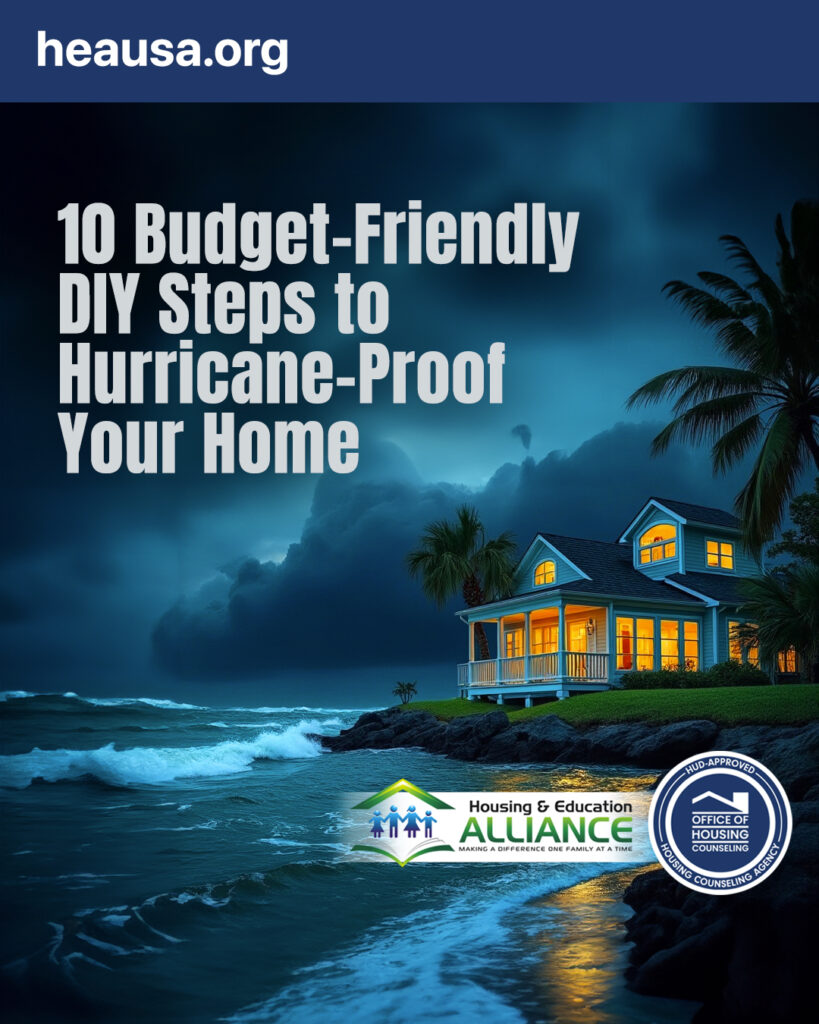
Hurricanes can be devastating, causing extensive damage to homes and neighborhoods. The high winds, torrential rain, and storm surges associated with these natural disasters can lead to significant property damage and safety risks. HEA understands the importance of your home – not only to provide shelter for your family, but an investment in your future. Happily, protecting your home from hurricane damage doesn’t always require a hefty budget. With some strategic planning and ten cost-effective measures, you can enhance your home’s resilience against these powerful storms.
- Assess Your Home’s Vulnerabilities
Before diving into specific measures, you need to understand the vulnerabilities of your home. Conduct a thorough inspection to identify weak spots that could be susceptible to hurricane damage. Common areas to check include:
- Roof: Look for missing or damaged shingles, loose flashing, and any signs of wear and tear.
- Windows and Doors: Check for weak or damaged frames, cracked glass, and gaps around the edges.
- Garage Doors: Assess the strength and condition of your garage door, as it can be a major entry point for wind and water.
- Foundation: Examine the foundation for any cracks or signs of instability.
- Reinforce Your Roof
The roof is one of the most vulnerable parts of your home during a hurricane. Reinforcing it can help prevent leaks and damage. Here are some budget-friendly options:
- Inspect and Repair: Regularly check for loose or damaged shingles and replace them as needed. Apply roofing cement to seal any gaps or cracks.
- Roof Straps: Install roof-to-wall straps or clips to help keep the roof securely attached to the walls. This can be a DIY project with minimal tools.
- Roofing Tape: Use weather-resistant roofing tape to seal any small leaks or gaps.
- Strengthen Windows and Doors
Windows and doors are critical points of entry for wind and debris. Here’s how to fortify them affordably:
- Storm Shutters: Install DIY storm shutters made from plywood or polycarbonate panels. You can also use hurricane fabric, which is a more affordable and lightweight option.
- Window Film: Apply impact-resistant window film to existing windows. It helps to hold glass in place if it shatters, reducing the risk of injury and water damage.
- Door Reinforcement: Add extra hinges and use door braces to strengthen exterior doors. Ensure they are securely installed and fit snugly within their frames.
- Protect Your Garage Door
Garage doors can be particularly vulnerable during a hurricane. Reinforce yours with these cost-effective methods:
- Garage Door Bracing: Install a garage door bracing kit to add extra support. These kits are relatively inexpensive and can be installed as a DIY project.
- Reinforce Tracks and Panels: Check the tracks and panels for any signs of weakness and reinforce them if necessary. Use metal brackets or additional screws for added stability.
- Seal and Secure Your Home
Proper sealing can help prevent water from entering your home and causing damage:
- Weather Stripping: Install weather stripping around doors and windows to prevent drafts and water intrusion. This is a simple and affordable DIY project.
- Caulking: Apply exterior-grade caulk to seal gaps and cracks in the siding, foundation, and around windows and doors.
- Flood Barriers: Use sandbags or inexpensive flood barriers to protect low-lying areas around your home from potential water intrusion.
- Trim Trees and Landscaping
Overhanging branches and unkempt landscaping can become dangerous projectiles during a hurricane. Maintain your yard with these tips:
- Tree Trimming: Regularly trim trees and remove dead or overhanging branches that could fall on your home. This helps to reduce the risk of damage from falling debris.
- Secure Outdoor Objects: Bring in or secure outdoor furniture, decorations, and other objects that could become windborne projectiles.
- Prepare Your Home’s Exterior
Ensuring the exterior of your home is secure can help minimize damage:
- Gutters and Downspouts: Clean gutters and downspouts regularly to ensure proper drainage. Install gutter guards to prevent debris from clogging them.
- Siding and Trim: Inspect and repair any damaged siding or trim. Consider applying a weather-resistant sealant to protect against water infiltration.
- Exterior Paint: Use weather-resistant paint on exterior surfaces to provide an extra layer of protection against the elements.
- Create a Hurricane Emergency Plan
Having a plan in place can help you respond effectively when a hurricane approaches:
- Emergency Kit: Assemble a basic emergency kit that includes essentials such as non-perishable food, water, first aid supplies, flashlights, and batteries.
- Evacuation Plan: Familiarize yourself with local evacuation routes and shelters. Make sure all family members are aware of the plan and practice it regularly.
- Important Documents: Store important documents, such as insurance papers and identification, in a waterproof container.
- Insurance and Financial Preparation
While not directly related to physical hurricane-proofing, ensuring you have adequate insurance coverage can provide financial protection in the event of damage:
- Review Insurance Policies: Review your homeowner’s insurance policy to ensure it covers hurricane damage. Consider adding flood insurance if you live in a flood-prone area.
- Document Your Property: Take photographs or videos of your home and belongings for insurance purposes. Keep a record of any recent improvements or repairs.
- Community and Local Resources
Sometimes, local resources and community programs can offer assistance with hurricane preparedness:
- Community Programs: Check if there are any local programs or initiatives that offer free or discounted hurricane preparedness resources.
- Volunteer Organizations: Volunteer organizations may help low-income and disabled residents with securing homes or distributing emergency supplies.
Be Prepared With HEA and Car Credit
Hurricane-proofing your home on a budget requires a combination of strategic planning, DIY projects, and regular maintenance. The Housing and Education Alliance encourages all Tampa Bay residents to stay informed about the weather and make early preparations throughout hurricane season. Remember, while you can’t control the weather, you can control how well you prepare for it.
Nuevo en US (www.nuevoenus.org) appreciates the dedication of the Housing and Education Alliance as a Strategic Partner, welcoming and assisting newcomers to our country. Car Credit (www.carcredittampa.com) is proud to support the vital work of Nuevo en US and its partners, making our community safer, stronger and more inclusive.








